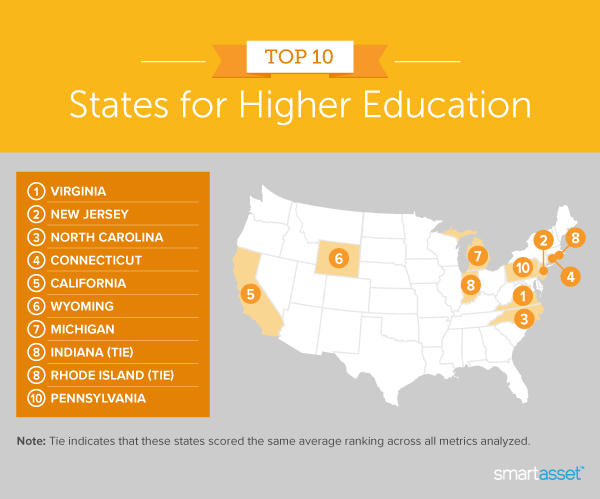Over the past decade, the cost of a college education in the U.S. has increased significantly. Accounting for inflation, data from the Integrated Postsecondary Education Data System (IPEDS) shows that prices for undergraduate four-year public and private institutions rose respectively by 22.84% and 21.20% between school years 2008-2009 and 2018-2019. Notably, however, public universities remain distinctly more affordable. In 2018-2019, the average net price of attendance (i.e. total cost minus grant and scholarship aid) among four-year public universities was $12,607. Four-year private universities by comparison cost almost twice as much, roughly $23,000.
As public universities tend to be the most affordable for in-state students, SmartAsset took a closer look at the best states for higher education. Specifically, we compared states across five metrics – undergraduate graduation rate, average net price, student-to-faculty ratio, 20-year return on investment and in-state attendance rate – and used that data to create a final ranking. For details on our data sources and how we put the information together to create our final rankings, check out the Data and Methodology section below.
This is SmartAsset’s seventh annual study on the best states for higher education. Check out the 2020 edition here.
Key Findings
- California and Wyoming move up. In last year’s edition of our study, California and Wyoming ranked ninth and 10th, respectively. This year, they are the fifth- and sixth-best states respectively for higher education, moving up primarily because of improvements in their undergraduate graduation rates. During the 2017-2018 school year, we found that both California and Wyoming had undergraduate graduation rates of 57%. In 2018-2019, the average undergraduate graduation rates for four-year public colleges and universities in California and Wyoming rose to 59% and 60% respectively.
- Southern states rank poorly. Despite two Southern states ranking in our top 10 states for higher education – Virginia and North Carolina – 10 of the 16 Southern U.S. states (according to Census regional divisions) rank in the bottom half of the study.

1. Virginia
Virginia ranks in the top 10 states for three of the metrics we considered: undergraduate graduation rate (72%), student-to-faculty ratio (less than 16 students per faculty member) and 20-year return on investment (about $403,200). Virginia also has the 19th-highest in-state attendance rate, with close to one in four high school graduates attending one of its four-year public colleges or universities.
2. New Jersey
New Jersey has the third-highest undergraduate graduation rate in our study (roughly 70%) and the sixth-highest 20-year return on investment ($429,715). The Garden State also has the 14th-lowest student-to-faculty ratio, with a weighted average of 15.92 across four-year public colleges and universities in the state.
3. North Carolina
North Carolina has the second-highest in-state attendance rate of the schools in our top 10 and the 10th-highest overall. About 27% of the state’s high school graduates attend a four-year public college or university in North Carolina. Additionally, North Carolina has the seventh-highest undergraduate graduation rate (roughly 67%) and the 13th-lowest average net price ($12,748).
4. Connecticut
Connecticut is home to 11 four-year public colleges and universities. The weighted average undergraduate graduation rate across those schools is about 67%, the sixth-highest across the 49 states in our study. Connecticut also ranks in the top 15 states for its favorable student-to-faculty ratio (14.98) and high 20-year return on investment (about $384,200).
5. California
Students attending one of California’s four-year public colleges or universities are likely to have a sizable return on their investment as it is the highest in our study (about $480,400 after the cost of the degree is deducted). This means that in the 20 years following schooling, the average college graduate earns about $480,400 more than the average high school graduate working during those 24 years. This high return on investment may partially be a product of the low cost of higher education attendance in California. The average net price is seventh-lowest in our study (less than $11,200).
6. Wyoming
Wyoming ranks in the top 15 states for four of the five metrics we considered. It has the 15th-highest undergraduate graduation rate (60%), the 14th-lowest average net price ($12,880) and the sixth-lowest student-to-faculty ratio (15). It also has the 15th-best 20-year return on investment, with the average college graduate earning $379,000 more than the average high school graduate.
7. Michigan
The largest four-year public universities in Michigan are Michigan State University and the University of Michigan, with undergraduate enrollment at roughly 39,200 and 31,300 respectively for the 2018-2019 school year. The state as a whole (including all other four-year public colleges and universities) ranks well on several of our metrics. Michigan has the 19th-highest undergraduate graduation rate (58%), 13th-lowest student-to-faculty ratio (15.87), 17th-highest 20-year return on investment (about $361,300) and 20th-highest in-state attendance rate (23%).
8. Indiana (tie)
Indiana ranks in the top 20 states for three metrics: average net price, 20-year return on investment and in-state attendance rate. IPEDS data shows that the average net price for four-year public universities in Indiana is $11,640 during the 2018-2019 school year. Additionally, the 20-year return on investment is about $355,800 and in-state attendance rate is 27%.
8. Rhode Island (tie)
Rhode Island ties with Indiana as the No. 8 state for higher education in the U.S. It claims top spots for low student-to-faculty ratio (15.08) and its high undergraduate graduation rate (63%). But the state falls behind most when it comes to higher education costs. The average net price is 39th-highest in our study ($16,562).
10. Pennsylvania
Pennsylvania rounds out the top 10 states for higher education in our 2021 study. While public colleges and universities in Pennsylvania tend to be more expensive, the state ranks in the top 15 for two metrics: undergraduate gradation rate and student-to-faculty ratio. According to data from the 2018-2019 school year, the undergraduate graduation rate across public colleges and universities in Pennsylvania is 67% and the student-to-faculty ratio is less than 16.

Data and Methodology
To determine the top states for higher education, SmartAsset analyzed data across 49 states (Delaware was missing comprehensive data). We considered the following five metrics:
- Undergraduate graduation rate. Data comes from the Integrated Postsecondary Education Data System (IPEDS) and is for the 2018-2019 school year.
- Average net price. This is the average yearly net price charged to first-time, full-time undergraduate students who were awarded grant or scholarship aid. Data comes from IPEDS and is for the 2018-2019 school year.
- Student-to-faculty ratio. Data comes from IPEDS and is for the 2018-2019 school year.
- 20-year return on investment. This is the difference between 20 years of median pay for a graduate with a bachelor’s degree minus the costs for attending the higher education institution for four years and 24 years of median pay for a high school graduate. Data comes from Payscale.
- In-state attendance rate. This is the percentage of students who graduated high school in 2018 and attended an in-state college. Data comes from IPEDS and the Western Interstate Commission for Higher Education.
We looked exclusively at four-year public colleges and universities. Metrics were calculated using a weighted average of the schools in each state according to undergraduate enrollment size.
First, we ranked each state in every metric, giving a double weighting to the undergraduate graduation rate and a single weighting to all other metrics. We then found each state’s average ranking and used the average to determine a final score. We graded our score on a curve, with the top 15% of states receiving a grade of A and the bottom 15% receiving a grade of F.
Education Saving Tips
- Consider a 529 plan. 529 college savings plans are tax-advantaged savings vehicles that help investors put money away for future education costs. If you want to learn more about 529 plans check out our guide here.
- Talk to an expert. With tuition costs rising so rapidly, speaking with a financial advisor sooner than later may be advantageous. A financial advisor may be help you start planning and saving for future education costs and create a comprehensive financial plan. SmartAsset’s free tool matches you with financial advisors in five minutes. If you’re ready to be matched with advisors that may be able help you achieve your financial goals, get started now.
Questions about our study? Contact us at press@smartasset.com.
Photo credits: ©iStock.com/Halfpoint
